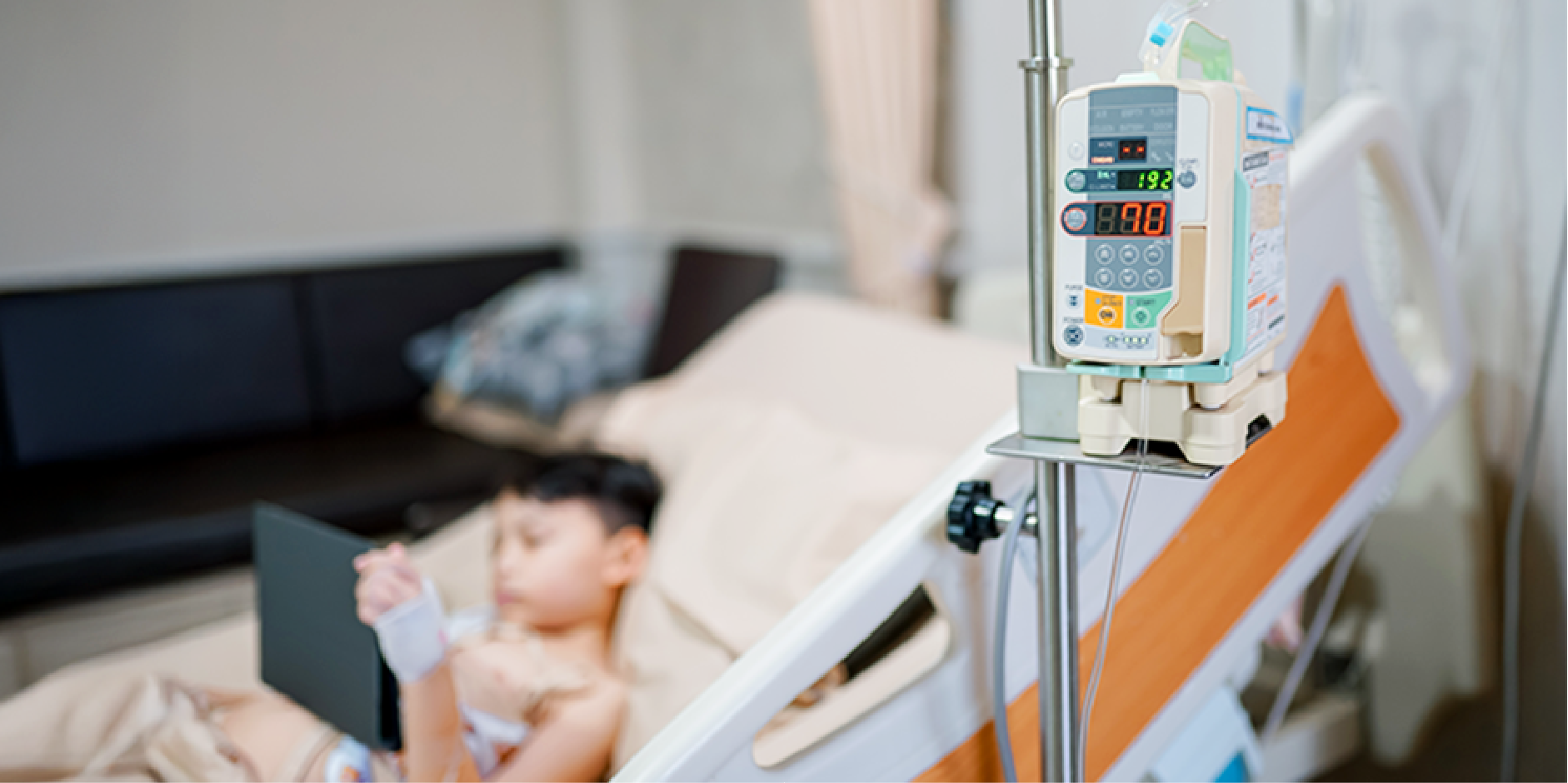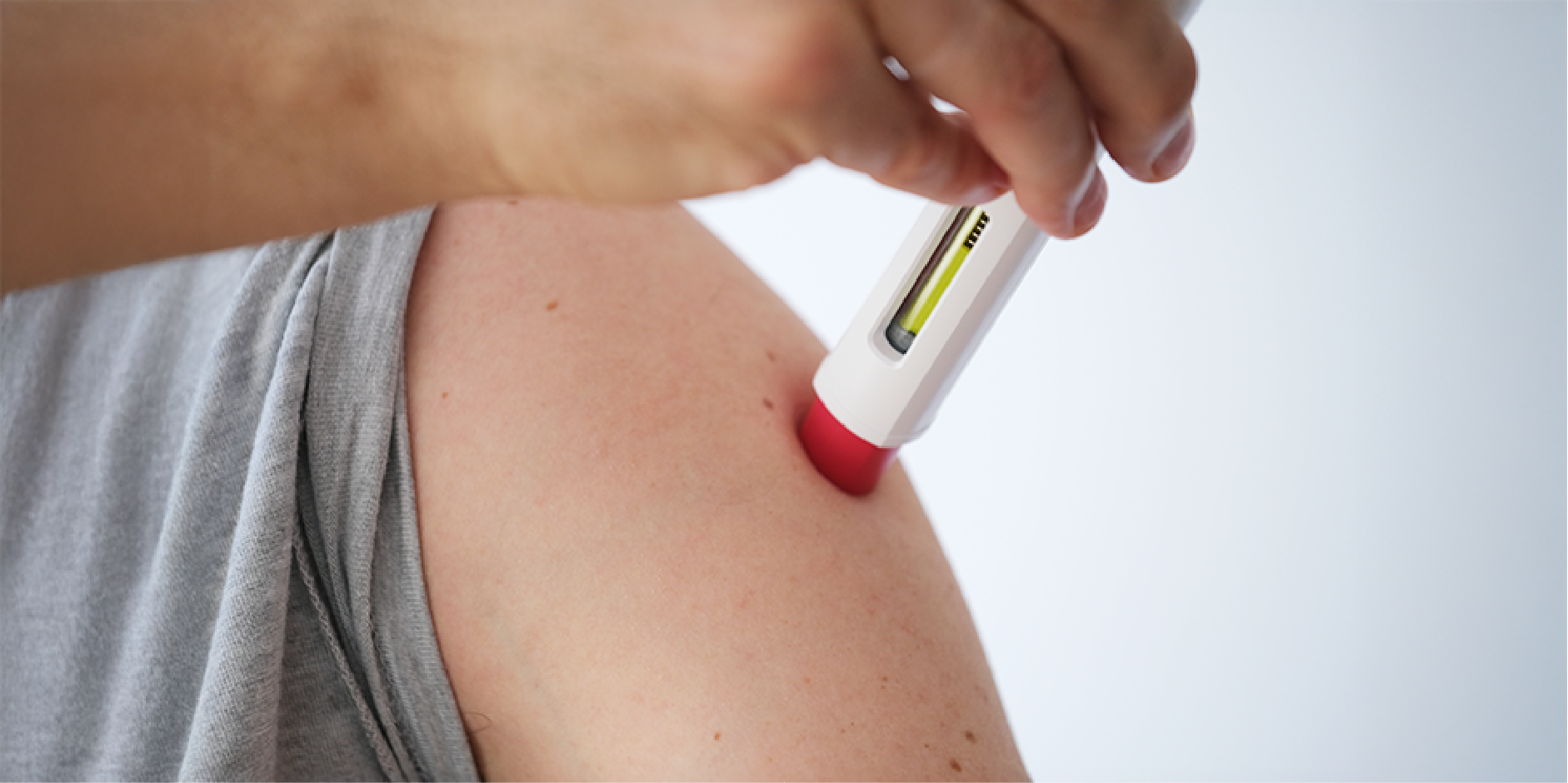Content on this page:
Content on this page:
Pharmacological therapy
Immediate Management
In anaphylaxis, Epinephrine is administered 1:1,000 dilution (0.01
mg/kg) at a dose of 0.01 mL/kg (max dose: 0.3 to 0.5 mL or 0.3 to 0.5 mg) every
5 to 15 minutes, until condition stabilizes. The dose is equivalent to 10
mcg/kg. IM injection into the lateral side of the mid thigh is the best route
and site to give Epinephrine to treat an anaphylactic reaction. IM injections
in the thigh produce more rapid absorption and higher plasma Epinephrine
concentration than IM injection in the arm.
The following doses per patient weight are recommended:
- Patients weighing 7.5 to 15 kg or <12 months old: 0.1 mg (may consider giving 0.15 mg in patients weighing 7.5 to 10 kg)
- Patients weighing 15 to 30 kg or <6 years old: 0.15 mg
- Patients weighing ≥30 kg or ≥6 years old: 0.3 mg
- Patients weighing ≥50 kg or adolescents: 0.5 mg
Inhaled
Epinephrine via metered dose inhalers or nebulizers may be beneficial to treat
laryngeal edema or persistent bronchospasm in cases where IV route cannot be
obtained or despite a previous IM Epinephrine dose. The
recommended dose for patients weighing ≥30 kg is 2 mg x 1 spray in
1 nostril. Repeated
doses of Epinephrine are administered until clinical improvement is achieved.
If there is no improvement after 3 to 4 doses, the patient should be
transported to an emergency medical facility.
Subsequent Management
Epinephrine IV Infusion
Epinephrine
IV infusion is indicated during cardiac arrest or in profoundly hypotensive
patients who have failed to respond to ≥3 injection doses of Epinephrine and IV fluid replacement. This may be
prepared by adding 1 mg (1 mL) of 1:1,000 dilution of Epinephrine to 250 mL of
D5W to yield 4 mcg/mL. It is infused at a rate of 1 to 4 mcg/min with a max of
10 mcg/min for adolescents. An alternative is the “rule of 6”, 0.6 times body
weight (kg) = number of mg diluted in 100 mL of saline, then 1 mL/hour delivers
0.1 mcg/kg/min. Continuous cardiac monitoring is recommended due to potential
for lethal arrhythmias and to minimize the risk of overtreatment and
Epinephrine toxicity. Possible Epinephrine toxicity is considered instead of
worsening anaphylaxis in patients with normal or elevated SBP who are nauseous,
vomiting, shaky or tachycardic.
 Anaphylaxis (Pediatric)_Management 1
Anaphylaxis (Pediatric)_Management 1Adjunctive Therapy
Antihistamine (H1- and H2-receptor Antagonists)
Antihistamines are used in the treatment of urticaria-angioedema or pruritus related allergic reactions. H1 antihistamines are considered second-line agents to Epinephrine but are not replacements for Epinephrine in anaphylaxis treatment. The combination of H1- and H2-receptor antagonists has been reported to be more effective in anaphylaxis than H1-receptor antagonist alone. Combination or alone, both H1 and H2 antagonists are second line only to Epinephrine. They lack high quality evidence that supports their use in the emergency treatment for anaphylaxis.
Corticosteroids
Example drugs: Hydrocortisone, Methylprednisolone, Prednisolone, Prednisone
Corticosteroids are used to prevent recurrence of symptoms of protracted anaphylaxis and biphasic reactions. They may be given in patients with a history of idiopathic anaphylaxis and asthma, and in patients who experience severe or prolonged anaphylaxis. The recommended IV/PO dose of Methylprednisolone or equivalent formulation is 1 to 2 mg/kg up to 125 mg per dose. It should be discontinued once full recovery is achieved. It must be noted that steroids should not be used as a replacement for Epinephrine as first-line agents. They are not to be given for acute anaphylaxis management. For mild-moderate attacks, oral administration of Prednisone is recommended. For severe anaphylaxis, Methylprednisolone IV is recommended to modulate the late-phase response.
Inhaled Bronchodilators
Example drug: Salbutamol (Albuterol)
Inhaled bronchodilators are additional treatment for persistent bronchospasm not responsive to Epinephrine. They are not to be used as a replacement for Epinephrine as first-line agents. They are given intermittently or continuously, depending on the patient's symptoms and availability of cardiac monitoring.
Vasopressors
Example drugs: Dopamine, Norepinephrine, Vasopressin
Vasopressors are given if Epinephrine and fluid resuscitation have failed to alleviate hypotension.
Nonpharmacological
Immediate Management
Prompt
assessment and treatment are critical as death can ensue rapidly. A rapid
assessment of airway, breathing, circulation, and level of consciousness is
done. Triggering allergens are removed if possible (induce vomiting if
food-induced, stop drug intake or infusion, etc). The patient is placed in the
supine position with the lower extremities elevated if tolerated (left lateral
position for vomiting patients or in a comfortable position for patients with
dsypnea). Infants and young children should be held flat or horizontally in the
carer’s arm and not upright over the shoulder. Until fully stabilize, do not
let the patient sit up suddenly once supine as doing so can cause hypotension
and death.
Subsequent Management
It
is important to establish and maintain the airway. Endotracheal tube,
cricothyrotomy or needle cricothyrotomy may be performed if indicated.
Oxygen
(O2)
High
flow O2 (6 to 8 L/min) via non-rebreathing mask or endotracheal tube
in patients experiencing respiratory symptoms, hypoxemia, or hypotension
related to anaphylaxis should be provided. Continuous pulse oximetry and
arterial blood gas determination should guide O2 therapy.
Fluid
Support
IV
access is maintained using wide bore needles or cannulas (14 to 16 gauge). Rapid
administration of 1 to 2 liters of isotonic (0.9%) saline solution may be
indicated. In children, hydration is at 10 mL/kg for the first 5 to 10 minutes.
For hypotensive patients or those with cardiovascular collapse, IV
administration of normal saline at 20 mL/kg is recommended. If IV access is
delayed or impossible, an introspective route can be used. Inotropic support
with Dopamine or Epinephrine infusion should be started if >40 mL/kg is
needed. Invasive BP monitoring may be required. It is important to monitor the patient
for signs of overtreatment (eg hypertension or pulmonary edema).
 Anaphylaxis (Pediatric)_Management 2
Anaphylaxis (Pediatric)_Management 2Additional Interventions
Additional Interventions for Cardiopulmonary Arrest Occurring During Anaphylaxis
- Cardiopulmonary resuscitation and advanced cardiac life support measures
- Prolonged resuscitation efforts are encouraged
- High-dose Epinephrine (IV)
- Rapid volume expansion
- Consider extracorporeal membrane oxygenation (ECMO) if available
- Transport to ICU, as setting dictates
Patient Observation
Patient
observation is considered in post-anaphylactic patients due to the risk of
biphasic reaction or possible recurrence as the effect of Epinephrine wears
off. Biphasic reaction is the recurrence of symptoms after the initial episode
of anaphylaxis has resolved without any further exposure to the trigger. It is
associated with a greater severity of an initial reaction and persistence of
the reaction. It occurs in 1-23% of anaphylaxis cases. The onset of the second
phase of the reaction ranges from 1 to 72 hours after the initial reaction.
Risk factors for a biphasic reaction include more severe initial presentation
of anaphylaxis, initial reaction requiring >1 dose of Epinephrine, and delay
in Epinephrine administration. Children <16 years old should be admitted for
observation. Young people ≥16 years old should be observed for 6 to 12 hours
from onset of symptoms. The period of observation will vary from 4 to 24 hours
depending on the clinical situation. Patients with respiratory symptoms would
require 6 to 8 hours of observation. Patients with hypotension or shock will
require 12 to 24 hours of observation in the ICU. Longer periods of observation
may be provided to patients with risk factors for developing severe
anaphylaxis, those who required >1 dose of Epinephrine, or protracted
anaphylactic episode. Patients should be followed up for 7 days after the
observational period for the occurrence of biphasic reactions.
Patient, Guardian, and Caregiver Education
Patient,
parents, and caregivers should be able to apply the following objectives:
- Identify and avoid triggers and cofactors
- Recognize early warning signs and symptoms of anaphylaxis
- Risk of biphasic reaction
- What to do should an anaphylaxis episode occur again
- Medications prescribed and their indication
- Training on the correct use and timing of Epinephrine injector
- The need for referral to an allergy specialist (including the process of referral)
- Information about support groups
Education
and management plans should be individualized. At-risk patients should be
protected by wearing accurate and up-to-date medical identification listing their
confirmed trigger factors, relevant comorbidities, concurrent medications, and
emergency contact details. Individualized instruction and coaching may help to
diminish the anxiety among caregivers.
Indications
for Prescribing Self-injectable Epinephrine
- History of cardiovascular or respiratory reaction to an allergen (eg food, latex, insect sting)
- History of Hymenoptera venom allergy in untreated patients with more than cutaneous or mucosal systemic reactions or high risk of re-exposure
- History of treatment with Hymenoptera venom immunotherapy in patients with more than cutaneous or mucosal systemic reactions at high risk of relapse
- Food-induced anaphylaxis associated with
exercise
- At least 2 auto-injections should be prescribed and carried at all times by patients at risk for food-induced anaphylaxis
- Patients with food allergy and co-existent persistent asthma
- Idiopathic anaphylaxis
- Children with severe skin involvement (>50% body surface), increased basal serum tryptase levels and with blistering in the first 3 years of life
- Previous reaction to small amounts of food
- History of only a previous mild reaction to a tree nut or peanut
- Severe allergic reaction in an adolescent
- Remote location without rapid access to medical facility
- History of Hymenoptera venom or drug allergy in patients with more than cutaneous or mucosal systemic reactions and cardiovascular disease
- History of oral immunotherapy for food allergy
 Anaphylaxis (Pediatric)_Management 4
Anaphylaxis (Pediatric)_Management 4
Referral to an Allergist-Immunologist
Patients
should be referred to an age-specific allergy specialist at the earliest
possible time after the reaction.
Referral
to an allergist-immunologist is indicated in the following circumstances:
- To take a full allergy-focused history
- To perform tests to determine the cause of anaphylaxis and confirm the diagnosis
- To develop an individualized management plan and be able to train the patient and caregivers to ensure implementation of the management plan
- To offer information on avoidance and control of confirmed trigger factors
- If symptoms are recurrent or difficult to control
- If the patient is a candidate for immunotherapy or desensitization
- If daily medications for prevention are required
